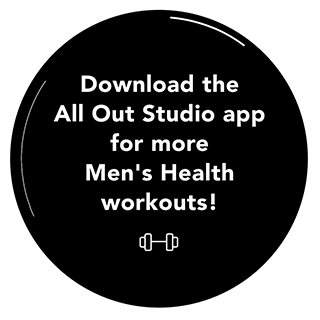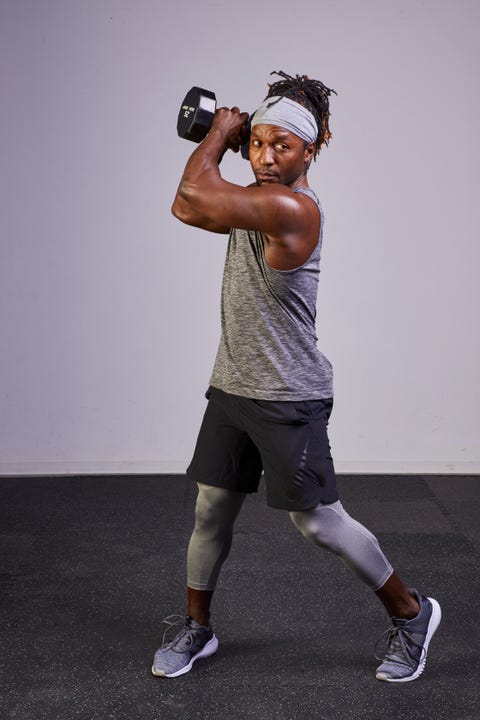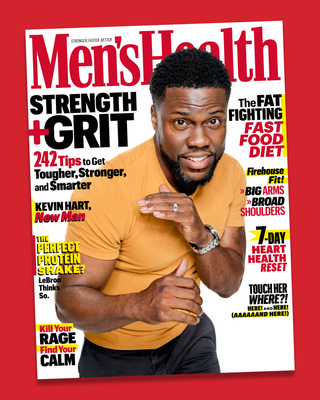5 Reasons Guys Over 40 Should Try HIIT Training
If all you know about high-intensity interval training (HIIT) comes from what you’ve seen on YouTube videos, fitness influencer Instagram accounts, or overpriced boutique gym concepts, you might be under the impression that HIIT is a young man’s game. Hill sprints, box jumps, and kettlebell snatches can be great exercises for burning fat in short workouts, but they’re not always appropriate for guys who have a few miles on their joints.
Fortunately, HIIT can include virtually any exercise you like to do, and workouts can be modified to help you get stronger, leaner, and better conditioned at any age. Gerren Liles, creator of the Men’s Health High-Power HIIT program on the All Out Studio app, knows this better than anyone. Though he began weight training in high school, he avoided cardio and trained like a bodybuilder. He got big alright—but not healthy. “I was diagnosed as pre-diabetic,” he says, “and I was only in my early thirties.”

Men’s Health
DOWNLOAD THE PROGRAM HERE
Liles hired a trainer and cleaned up his diet. He fell in love with fitness so much that he became a personal trainer and NASM certified in 2009. He started taking group fitness classes to gain experience and network with other trainers, and that’s when he discovered HIIT. Now, at age 43, Liles competes in Spartan races, and says HIIT plays a big role in the training he does to prepare for them. “I still take HIIT classes,” Liles says, “to keep up my explosiveness and endurance.” Liles performs two to three days of HIIT per week, and another two to three days of pure strength training.
Liles created exclusive HIIT workouts just for Men’s Health on the All Out Studio app. You can even try one of his full workouts from the program on our site. Here’s how he convinces guys over 40 not to fear HIIT, and how to make it work in their training.
5 Reasons You Should Do HIIT Even if You’re Over 40

Philip Friedman
1. HIIT saves time.
“Interval training means alternating short bursts of hard work and periods of light work, or rest,” says Liles. “You don’t work as long in a HIIT session as you do with steady-state cardio, but you work much harder.” A position statement from the American College of Sports Medicine (ACSM) confirms that, as a result, HIIT workouts tend to burn more calories than aerobic work—at least per minute of exercise.
That makes HIIT a great workout choice for busy fathers, those with erratic work schedules, or anyone else who has trouble making it to the gym or committing to a workout that requires upwards of an hour’s time investment. “You can do a solid HIIT routine in 15 minutes,” says Liles.
2. HIIT burns fat.
“It’s one of the most tried and true methods to assist in weight loss,” says Liles. “HIIT asks a lot more of your muscles than steady-state cardio, so it gets your heart rate higher.” Not only do you burn a lot of calories during the session, you’ll continue to burn them at a greater rate after the workout is over—an effect you don’t get from jogging on a treadmill.
The ACSM estimates that you can burn up to 15 percent more calories for two hours post-exercise, as your body works to recover from the intensity of the session. That means a 40-plus guy can actually get leaner while he’s driving, sleeping, reading, or watching TV (as long as he’s not eating a bag of potato chips during the show).
3. HIIT improves both strength and endurance.
“As we get older, we tend to adopt a more sedentary lifestyle,” says Liles. “It’s easy to let either your cardio or strength workouts lapse, if not both. But HIIT can give you a mix of both types of training in the same workout.” HIIT routines can include classic muscle exercises like pushups and squats, as well as heart-pumping calisthenics like jumps and mountain climbers.
If you can only work out once in the next few days, a HIIT session will give you the most for your money. “I tend to do two to three days of HIIT per week,” says Liles, “and another two to three days of pure strength training.”
4. HIIT can be scaled to any fitness level.
Don’t worry if you can’t do the fancy exercises you see people do for HIIT workouts in CrossFit gyms or online. Liles has an easy formula to help you design your own HIIT routines. “You always want to do some sort of squat, hinge, push, and pull movement,” he says, “since all those movements are present in our daily lives.”
You can cover those categories with a simple bodyweight squat, kettlebell swing, pushup, and bodyweight row, for example. “If your goal is fat loss, a 1:1 or 2:1 work-to-rest ratio is usually ideal,” says Liles. So you’d perform an exercise for, say, 30 seconds, and then rest 30 seconds (1:1), or 15 seconds (2:1).
“Just use common sense,” says Liles. “If you can’t execute a movement with good form due to fatigue, rest longer before you perform the next interval. For example, you could do jumping jacks for 20 seconds and rest 10 seconds in between. But if you’re doing something more complex, like a burpee, you may need to rest one minute to recover.”
5. HIIT is fun!
Because interval workouts can encompass so many athletic exercises, and they force you to move at a fast pace, they can make you feel like an athlete again—even if you haven’t played a sport since you were in school. This can be key for keeping you motivated to train, in your forties and beyond. And the longer you train, the better your results.
“HIIT can help you maintain endurance and explosiveness,” says Liles, “as well as strengthen your cardiovascular system to help you ward off heart disease, manage insulin levels, and, of course, look good well into old age.”
The High Power HIIT Routine
Try this HIIT workout from Liles. There are 4 groups of exercises that you’ll do in circuit fashion. Perform reps of each exercise in a group for the recommended amount of time in the work period, and then rest after the last exercise in the group. Then go on to the next group. When you’ve finished each group of exercises, rest 2 to 3 minutes, and repeat the entire workout for 2 to 3 total rounds.
Group 1
Air Squat – 45 seconds
Squat Jump – 30 seconds
Squat Hold – 15 seconds
Rest: 60 seconds
Group 2
Pushup – 45 seconds
Mountain Climber – 30 seconds
Forearm Plank – 15 seconds
Rest: 60 seconds
Group 3
Alternating Lateral Squat – 45 seconds
Lateral Shuffle – 30 seconds
Sumo Squat Hold – 16 seconds
Rest: 60 seconds
Group 4
V-Up – 45 seconds
Side Plank with Reach – 30 seconds
Side Plank Hold – 15 seconds
Rest: 2 to 3 minutes, and repeat for 2 to 3 total rounds

Source: Read Full Article
